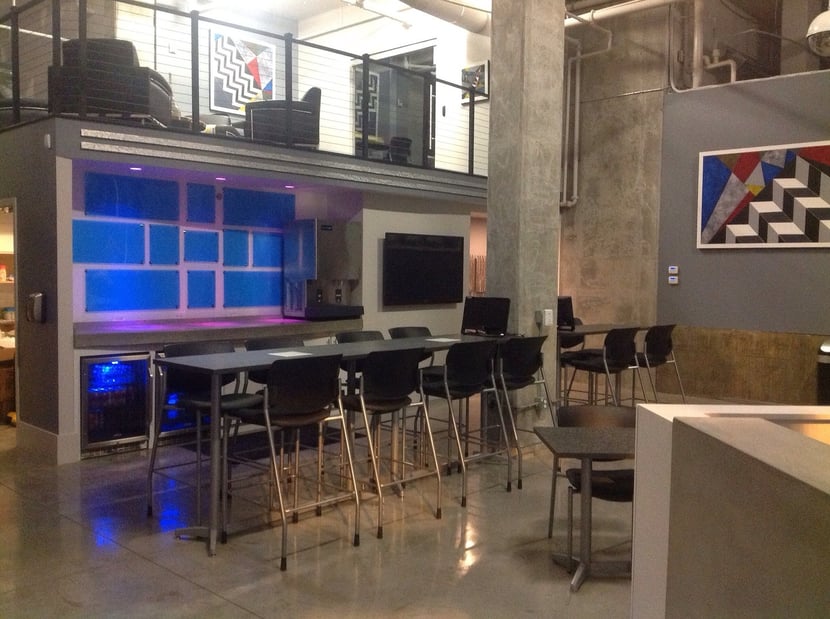%20copy%205.png?width=1574&height=714&name=Interview%20Blog%20Header%20(5)%20copy%205.png)
What is Flexible Space Costing You?

Flexible space has grown rapidly in the past few years. It now accounts for 5% of the global office space market. That’s still a relatively small fraction, but it’s enough to radically change the way companies think about office space.
In many ways, that’s a good thing. Companies from startups to large global corporations have a larger pool of coworking, short-term and flex space options to consider, making it easier for them to tailor their workplace to their needs and save money.
But all these options can pose a challenge for decision-makers. Budgeting for the cost and planning the logistics of providing cubicles or offices for, say, 50 workers in a traditional office environment is a relatively straightforward process. But with flexible space, you’re comparing apples to oranges. It’s hard to weigh the benefits of a traditional midtown office, versus a short-term lease in the warehouse district, vs. renting desks as workers need them.
Because of both the freedom and the challenges posed by the rise of flexible space, we decided to look at how business owners are already using these spaces, what it’s costing them, and what they can teach others considering flexible office solutions.
What Does Cost Mean With Flexible Space?
Flexible space is not always simply an alternative to traditional leases. Although it can be a good choice for some companies using fairly traditional office environments, with everyone located in the same flexible space, it can also serve radically non-traditional workplaces, including:
- Partners and solo entrepreneurs who rent flexible space by the day as they need it.
- Business travelers who use flexible space as a way to give themselves more options, in addition to coffee shops and other alternatives.
- Business owners who only occasionally rent flexible space for meetings
- Companies with no offices at all, that provide stipends for remote workers who want to use flexible space
In these unconventional approaches to office space, it can be hard to calculate the costs of flexible space compared to the cost of alternatives. For example, let’s say you’re a business traveler who regularly needs to find places to work on the road.
Depending on local amenities, you may have a lot of choices available to you, including flexible spaces, coffee shops, public facilities and your hotel room. To price out the different options, you’d need to look at not just the cost of each, but also the time cost of finding a coffee shop with good WiFi, lost productivity when the public space is too loud or the hotel wireless goes out, and your own work habits.
On top of that, there are the networking opportunities in a flexible space. If you’re getting extra business from sharing a space, how much is it worth to you? What would be the cost of recruiting that much business outside a coworking space?
Additionally, changing usage patterns can affect the cost/benefit analysis of a coworking space. Start renting coworking space by the day and end up using it more frequently than anticipated, and you can easily go over budget. On the other hand, if you sign up for a lease for a coworking space, you may be forced to pass up a newer space that’s a better fit for you.
In short, it’s not enough to weigh the real estate cost of flexible space against the cost of a traditional office space. You’ll need to look at all the ways your work life will be different, and the associated costs. If you’re using a flexible space as a direct alternative to a standard office, that cost comparison can be pretty straightforward. But if you’re using it as part of an alternative strategy to a traditional office environment, it can get a lot more complicated.
 Long-term Rental vs. Flexible Workspace: Basic Cost
Long-term Rental vs. Flexible Workspace: Basic Cost
Like other real estate rentals, the cost of flexible space varies tremendously from market to market, neighborhood to neighborhood, and even landlord to landlord within the same city. The basic cost of flexible space is often lower than that of a traditional lease, but a deeper look at costs reveals that the situation isn’t always that simple.
For SMEs in some of the most expensive cities, coworking spaces really can save a lot of money. A recent study found that in Hong Kong, the most expensive city for office space rental, flexible space can save over $20,000 per year on the cost of a single desk. According to the study, renting desk space costs $27,432 per year in Hong Kong under a traditional lease, but only $7,607 per year in a flexible workspace lease — a 72 percent savings.
However, the savings are more modest in other major cities like New York (16 percent) and Paris (17 percent). And in cities with less flexible space and lower rental prices,, they could be even lower. That’s still significant, but for many companies it may not be enough savings to outweigh the drawbacks of shared flexible space.
Coworking Spaces: the Fine Print
While coworking space may have a lower “sticker price” in many areas, the numbers are deceptive. With the leverage of signing a multi-year contract, companies can generally get better deals than they could get from coworking. In fact, in the markets we serve like Nashville and Austin, coworking space often has a higher cost per square foot. According to Austin, Texas TenantBase advisor Chad Wallace, coworking spaces in the Austin area are more likely to benefit startups than more established companies.
“They are more expensive than traditional offices on a long-term budget, but for a young company that is growing they are cheaper than leasing an office large enough to accommodate their expected employee count once they are done growing from the get go. Flexibility is an underrated commodity for young and growing businesses.”
One of the reasons why traditional leases are often less expensive than coworking and flexible space is that you have leverage. In a flexible coworking lease, your business is just a bunch of bodies to fill desks or rooms temporarily. Keeping as much of the space occupied as possible while people come and go imposes costs on management, which they have to recoup through rent.
In a traditional lease, however, you’re typically staying on for at least three years. The landlord gets to have the full office space rented out. And if you don’t rent, they can’t just sell off seats until its full — it may take months to find the right tenant, negotiate a commercial lease and build it out, during which they’ll be losing money on a vacant space. That makes you more valuable to them, which often translates to more favorable terms.
This is especially true for companies that are willing to look beyond expensive turnkey real estate. If you’re relocating to a property that needs a lot of work and are willing to perform the buildout, for example, you’ll be making the building more valuable for the landlord. Often, that enables you to negotiate a very favorable rate in exchange for making improvements.
Additionally, coworking spaces often have extra costs associated with them that aren’t obvious from the get-go. For example, if you’re in a traditional office, you can setup your office as you please, with your laptop, extra-large monitor, tablet, headphones, ergonomic desk chair and whatever other supplies you need. If you’re in a shared office space, however, you’ll need a space to store your things. While many coworking spaces offer storage, there’s typically an extra cost involved, and those costs add up over time.
There are also other amenities that you may end up needing more than you think. If you haven’t worked in a coworking space before, it’s easy to underestimate your need for private rooms to have client meetings, discuss sensitive topics or simply get away from the chatter and distraction of a public workspace. And if you haven’t budgeted those spaces in from the beginning, renting a private room even a few times a month could cancel out your savings.
 Coworking Spaces: When Flexibility and Convenience Pay Off
Coworking Spaces: When Flexibility and Convenience Pay Off
While traditional leases generally suit traditional business situations, coworking spaces really shine at the margins — in situations where you really need the flexibility and convenience of a coworking space.
One big selling point of coworking spaces is their turnkey service. Between deposits, utilities and other costs, moving into a new office can be expensive. And as Nashville, Tennessee TenantBase Advisor Cameron Bice pointed out, coworking spaces generally come with all the basics — and often include some nice bonus amenities:
“If you are looking at it from a cost per square foot standpoint, coworking might not make sense. However, you have to include the all-in pricing and additional services that you may not get in a traditional office setting.
Basic things like printing, furniture, WiFI & phone services, utilities, and event spaces are usually not included in a traditional lease. Other things to consider are the concierge services, snacks, and refreshments that many coworking options offer. In Nashville, there are higher-end options as well as low-cost providers, but the main difference is the flexibility with lease terms.”
Bice points out that coworking spaces can also be a great option for businesses with minimal and short-term needs.
“They are perfect for people who need a physical mailing address but do not need a lot of space or might not want a longer-term lease. They are great for swing space while hiring a team, building-out a more permanent office, or to use as swing space during a transition or structure change.”
Coworking can also be a great asset for business travelers, particularly if you can find a coworking company that operates in all of the areas you work. Big coworking franchises like Office Evolution operate spaces all across the country, each offering a similar range of amenities and options, from business addresses and virtual offices, to meeting rooms and private offices.
Additionally, renting a dedicated office comes with extra perks that could be a big cost-saver for business travelers. Dedicated private spaces all come with around-the-clock access to shared workspace at any of their franchises across the nation, along with discounts on other types of rentals at other locations. If you’ve ever had to scope out new spaces or travel from coffee shop to coffee shop looking for good WiFi on the road, the benefit is obvious.
 The Break Even Point
The Break Even Point
Any office space you use is going to come with risks and calculated guesses. Overestimate profits, and you can end up stuck in a traditional lease with a space that’s too big (and too costly!) for your needs. Underestimate your need for coworking space, and your “occasional” desk rentals can turn into a major drain on your budget.
But while there is no hard and fast rule for choosing the right office space solution, there are a few rules of thumb that can help you choose between flexible spaces and traditional leases.
The simplest factor is how long you plan to be in the office. According to TenantBase advisor Charley Koones, “Coworking makes a ton of sense for tenants looking to sign a month-to-month, six months or one-year lease. When you get to that 2-year mark, then it becomes a little bit of question and you are going to want to start to compare it with other options the market has to offer.”
However, the situation is complicated by the difficulty of finding short-term leases.
“In the Austin are most traditional offices are not accepting leases under 3 years, much less under a year,” says Wallace.
The situation is similar in many other rapidly growing regions, where the market favors the landlord. Additionally, you need to consider the economic boom and bust cycle.
In favorable conditions, coworking spaces can help your company thrive by “providing perks that attract top talent such as coffee, beer and other specialty drinks on tap as well as a sense of community,” according to Wallace.
They also save time and may provide facilities you couldn’t afford otherwise.
“How many hours over the course of a year do your employees waste in the break room waiting for coffee to brew? Furthermore most small offices (under 1000 square feet) do not have room for conference rooms or a reception area.“
However, Bice points out that in tough economic conditions, these benefits may not justify the cost.
“In a down market where profits are harder to realize, I think many of these companies (tenants in coworking) may rethink their need for some of the amenities that are nice to have but not necessary and may look for lower-cost options.
If a business has a good idea of their growth projections and can find a good space that will work for 3+ years I think a traditional office option makes more sense.”
Finding the Perfect Office Space
The costs of flexible space are hard to calculate, and vary based on available commercial space, growth conditions, company needs and a variety of other factors. While a coworking space can be an easy win for solo entrepreneurs and other niche markets, for most companies they’re simply one more option to carefully consider.
Whether you’re working in a traditional office environment or a converted warehouse space, TenantBase can help you weigh all the options, and find and negotiate the right space, at the right price with the right terms.

%20copy%204.png?width=1574&height=714&name=Interview%20Blog%20Header%20(5)%20copy%204.png)